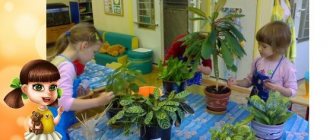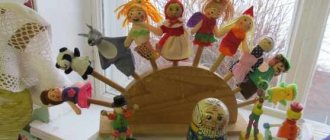Junior group
We offer simple and exciting games that younger preschoolers can handle.
What's in the bag?
The game teaches preschoolers to recognize and describe objects by tactile perception. The lesson requires fruits and vegetables familiar to kindergarteners in the younger group: tomato, cucumber, apple, onion, carrot, radish, pear and others. The teacher places the fruits in an opaque bag. Then he asks the pupils to take turns feeling for one of the objects in the bag, but not to take it out right away, but to try to describe it and give it a name.
Choose the right one
For the game you need images of different types of plants, their parts, fruits. The teacher lays them out on the table. Then he names a property or an external sign, and the students choose pictures with plants that correspond to this definition. For example, having heard the sign “orange”, children choose the pictures “orange”, “carrot”, “pumpkin”.
Where does it grow?
The game clarifies the idea of where plants grow. Beforehand, the teacher reminds the students that there are garden, meadow, garden, field, and forest plants. Children form a circle, and the teacher stands in its center. He throws the ball to each player in turn, names the plant, and the child must say where it grows: in the garden, vegetable garden, field, forest or meadow.
Find a plant
The game reinforces the idea of what different representatives of the flora look like. For the lesson you need cards depicting plants: several pictures of each type. The teacher lays out the cards on the playground, then names a specific plant species, for example, dandelion. The players' task is to find all the dandelion images among the pictures.
Find out by description
The game expands your understanding of the external features of different types of flora, teaches you to describe natural objects, and highlight their key features. For the lesson, we need images of plants known to younger preschoolers. The teacher lays out the pictures in front of the players, then gives a clear and detailed description of one of the presented types. Based on this description, players must guess what plant they are talking about.
Find the leaf
The game is played in the fall during a walk in the fresh air, promotes general physical development, improves auditory perception, and teaches you to identify objects based on similar characteristics.
The teacher picks up a fallen leaf from a certain tree from the ground, shows it to the students, and asks them to find the same one. Children perform a similar task for each type of tree: birch, maple, ash, aspen, oak, rowan and others available in the kindergarten yard. Then the teacher gives each child a leaf of a certain type and says: “The wind blew and carried maple leaves.” Children with a maple leaf in their hand begin to dance, spin, and run. The rest are standing still. The teacher gives a similar command for holders of other types of leaves.
Planting a tree
The game develops visual perception and orientation on a plane, improves fine motor skills. For it you need to prepare counting sticks, different geometric shapes cut out of thick paper, as well as natural material: seeds, cones, dried leaves, petals. Having received the playing material, children assemble different types of trees from it on a plane.
Proper care
Caring for indoor plants in kindergarten includes several stages. Children can also be involved in them.
- Watering is done with water at room temperature, left to sit for 1-2 days. 30-60 minutes after the procedure, the water is poured out of the trays;
- Spraying - carried out with water at room temperature from a fine-grained spray bottle. Helps keep plants fresh and green;
- Washing - to remove dust and dirt, plants that do not have pubescent leaves are periodically washed under a warm shower. The soil in the pot is covered with oilcloth;
- Loosening the soil - done the next day after watering to a depth of 1-1.5 cm;
- Transplantation is carried out when the roots have entwined the entire pot, mainly in the spring. The new pot should be 3-4 cm larger in diameter than the previous one;
- Fertilizing – fertilizing with mineral fertilizers is carried out 2-3 times a month after watering;
- Reproduction - can be carried out in different ways: seeds, cuttings, bulbs, dividing the bush, layering;
- Pest control – the most common dangers are spider mites, scale insects, aphids, and mealybugs. Insects are removed mechanically, after which the plant is washed with soapy water.
Did you like the article? Share it with your friends on social networks:
Middle group
We present educational and developmental games on the theme “The World of Plants” for preschoolers of the middle age group.
Whose seed is this?
The game teaches you to differentiate cultivated plants and their seeds, improves memory and concentration, and creates cognitive interest. For the lesson, you need recognizable images of vegetables, stone fruits and pome fruits, flowering crops, as well as real corresponding seeds and seeds: sunflower, pumpkin, apricot, cherry, apple, orange, cucumber and others. The game task is to correctly arrange the seeds and pits in the pictures.
What tree are the leaves from?
The game teaches you to identify the external signs of different types of trees. And the main feature is the leaves. For the game you need to prepare pictures of trees and corresponding images of leaves. Or collect and dry real leaves: birch, aspen, rowan, willow, oak, maple and others.
The teacher places stools in a row on the playground. There is a picture of a tree on each seat. The players are given images of leaves. At the starting signal, children run to the stools, look for a tree that matches the leaf, and sit on the seat.
Top or spine
To play you need two hula hoops of different colors, images of vegetables and root vegetables.
You can play in two ways:
- The teacher places the hula hoops on the floor so that they overlap slightly. One color hula hoop is for vegetables, the other is for root vegetables. And in the intersection zone, players must place images of those crops whose above-ground and underground parts are edible. Players take turns taking a picture, putting it in the right place, and justifying their decision.
- The teacher lays out images of tops and roots on the table. Players are divided into two corresponding groups and sort out the pictures. On command, children begin to run and dance. When the signal sounds, each root player must find his pair - the top.
We treat trees
The game fosters a caring and respectful attitude towards natural objects. The teacher and preschoolers go to the park, taking with them boards, pieces of fabric, scissors, cords, and water. There, children examine trees and bushes, looking for diseased specimens: withered, withered, with broken branches. The children’s task is to help the trees, to “cure” them using scrap materials.
Let's make a bouquet
The game teaches you to distinguish and name colors, quickly find a floristic object of a certain type among others, develops creativity, aesthetic taste, and the ability to beautifully arrange fresh flowers in shape and color. For this activity you need cut flowers and separate petals of the same species.
The game consists of 2 stages:
- The teacher lays out petals on the table and places flowers in vases with water. Each student takes turns taking a petal and calling it a color. Then he points to a flower whose petals are exactly the same color and shape.
- Children distribute the presented flowers so that they get beautiful and harmonious bouquets.
Floral ornament
For the game you need autumn leaves of different types of trees. The teacher shows how to lay out a linear ornament, alternating different leaves. Then the students create beautiful plant patterns on their own.
The game can be competitive. Children are divided into 2 teams. Each one creates an ornament according to the scheme presented by the teacher or at her own discretion. In the first case, the team that most accurately and quickly repeated the pattern wins; in the second case, the team that makes a more beautiful and neat pattern wins.
Harvesting
For the game you need pictures of fruits and vegetables. Preschoolers are divided into two teams. The first one harvests vegetables, that is, selects the corresponding pictures. The second one collects fruit. The team that harvests the crop the fastest wins.
Didactic games “Plants” in the senior group
We offer games for older preschoolers that expand and clarify knowledge about wild and indoor plants, their characteristics and places of growth.
Medicinal plants
The game reinforces ideas about the medicinal purposes of plants. The lesson requires pictures of medicinal herbs and shrubs known to preschoolers.
The teacher shows pictures one by one, and the children tell everything they know about the plant depicted: where it grows, what benefits it brings, what parts of it are used for medicinal purposes.
Didactic games “Indoor plants”
There are several games using indoor flowers. For classes, you need to choose potted plants that differ significantly in appearance and are familiar to preschoolers.
Game options:
- The teacher arranges flower pots in a row. First, he asks to name the plants in their order. For example, the second on the right side or the fifth on the left. Then the children perform the reverse task. The teacher asks, for example: “Where is the ficus?” The children answer: “He is third on the left side.”
- The teacher asks to name plants with certain characteristics. For example, with long hanging stems or with variegated leaves.
- Children look at the leaves of potted flowers. They share what they think the leaves of each plant look like.
- The teacher places 4–6 plants in a row. The students try to remember them, then close their eyes. The teacher removes one flower. Children, opening their eyes, try to remember which plant is missing. The game can be complicated by adding new plants to the row.
Ripe or not ripe
The game teaches you to visually determine the ripeness of fruits. The teacher lays out vegetables, berries, and fruits of varying degrees of ripening in front of the children. On command, children choose the ripest fruits among the fruits. At the second stage, they try to identify fruits of medium maturity.
The game can be active. The children are divided into two groups: the first receive ripe fruits, the second receive the same fruit, only unripe. Children dance and run to the accompaniment of music. And when the signal sounds, they try to find a friend with a similar fruit, only of a different degree of maturity.
Hang the fruit on the branch
Preschoolers are divided into two groups: the first receive branches of vegetable and tree crops, the second receive the corresponding fruits. On command, the children look for a pair, that is, they try to attach the fruit to a branch.
What types of flowers are there?
First, the teacher tells the students that there are garden, potted, forest, field, and meadow flowers. They differ in size, foliage, and inflorescences.
For the game you need images of flowers growing in different conditions. The game task is to divide the pictures into groups according to their location: forest, meadow, field, garden, house. During the differentiation process, players compare the external characteristics of plants and describe each species in detail.
Rules for landscaping a children's room
By caring for their green spaces, a child prepares for adulthood and learns to care for all life on Earth.
Having studied biology at school, we all know that plants not only absorb carbon dioxide, but also oxygen. Therefore, landscaping in a children's room should be done in accordance with the age of the child and depending on the area of the room.
Rules
- Until the child is six months old, it is not recommended to place any plants in the room at all, since green pets put an additional burden on the baby’s immune system.
- In the room of a six-month-old child, you can already place the first indoor flowers. You should not grow strong-smelling ones; for example, you should not decorate your room with geraniums. At this age, kids are interested in everything, so each plant should be located in the visibility zone, but out of reach, so that the child can look at the flower, but cannot “taste it for a tooth.”
- At the age of about a year or one year and a couple of months, toddlers are already trying to take their first steps. It is clear that they will want to get to know the flowers better. Therefore, the ideal solution for landscaping a children's room at this age would be hanging flower pots. You can place flowers on shelves located on the wall.
- Ages from 2 to 5 years are characterized by increased activity. The guys are interested in everything and they belong to the “why” category. Green plants will help your baby learn about the world around him.
By caring for his green spaces, a child prepares for adulthood and learns to treat all life on Earth with care.
Parents using the example of the Uzambara violet, aspidistra. geraniums or ficus will be able to explain the process of plant development. In addition, a child can be introduced to work by learning how to care for indoor flowers.
Preparatory group
We offer games to consolidate and generalize knowledge about flora, expand horizons, and develop cognitive activity in preschoolers preparing for school.
Make a plant from parts
The game requires pictures divided into parts, each part representing a specific plant organ: stem, root, leaves, flowers. The game task is to create a plant from parts of the picture. It is important that the depicted representatives of the flora belong to different categories: trees, shrubs, herbs, vegetables, flowers.
Didactic game “Groups of plants”
The teacher lays out 4 pictures in front of the players, depicting plants of certain groups. The game task is to identify the extra image.
Here are the categories:
- shade-loving plants - lily of the valley, sunflower, fern, ivy;
- wild - nettle, plantain, burdock, strawberry;
- blooming - juniper, aster, lilac, flax;
- medicinal - chamomile, hawthorn, sedge, coltsfoot;
- poisonous - henbane, clover, crow's eye, castor bean;
- conifers - spruce, pine, cypress, hornbeam.
Vegetable shop
Before the game starts, the teacher tells the children that agricultural crops are taken to vegetable warehouses for storage and to enterprises for processing and preservation. Fruits and vegetables that are stored fresh must be periodically sorted for spoilage. And those fruits that are immediately processed cannot be stored for a long time and quickly rot.
Children are divided into two groups: the first play farmers bringing the harvest, the second play specialists in receiving goods. To play the game you need to make images of different vegetables, berries, fruits, and also put two tables: one will be a vegetable storage, the second will be a processing plant. Each farmer player takes a picture, approaches the goods distributor with it, and he determines where the products will go: to storage or for processing.
Forester
A game played in the forest makes familiarization with plants more effective. The teacher, playing the role of a forester, goes with the children to the forest. This could be a forest belt, a city park. The forester lays out a convenient route for the children, but does not directly tell them where to turn, but describes a tree or bush, followed by a turn. Based on the description of the foliage, the color of the bark, the splendor of the crown and other parameters, attentive preschoolers must guess where to move.
Preview:
Consultation for educators
"Indoor plants in a corner of nature for every age group"
MDOU Child Development Center
“Indoor plants in a corner of nature for every age group. Selection and care of them"
Introducing children to nature in kindergarten requires constant, direct contact with it. One of the conditions that ensures this is the organization of nature corners in kindergarten. Each age group has its own corner of nature. Permanent inhabitants of the corners of nature in the kindergarten are indoor plants. They have been decorating human homes for a long time. Some of them bloom profusely and for a long time, others have beautiful foliage. Most plants come from tropical and subtropical countries: hot deserts and savannas, tropical rainforests and swamps. Indoor plants of different care (different soil, watering, degree of illumination, etc.). Indoor plants are valuable teaching material; they are obligatory inhabitants of a corner of nature.
Placing indoor plants.
Firstly, the plants must be positioned so that it is convenient for both adults and children to approach them. There are no more than two plants on the windowsills. Houseplants, in relation to light intensity, are divided into light-loving and shade-loving. Most plants are photophilous and develop better in strong light. Light-loving plants are those that grow in high, intense light (geranium, cacti, abutilon, fuchsia, gloxinia). It is better to keep them on or near a window.
Shade-tolerant plants can grow in light and light shade (asparagus, aloe, sansevieria, monstera). Shade-loving plants: aspidistra, begonias, clivia, ferns, tradiscantia. They grow well on windows facing north and west. When there is an excess of light, their leaves become lighter due to the reduction of chlorophyll grains in the cells. In dark places, shade-loving plants acquire a dense green color. In bright groups, rooms with windows facing south, east, west, many indoor plants can be successfully grown. Some plants are especially sensitive (geranium, fuchsia) to changes in position relative to the light source. Therefore, after a plant has been assigned a permanent place in the group, it should be spared from rearrangements. If you look at green plants, you can see that they all reach for the light and turn towards it, so in groups they often take on a somewhat one-sided shape. To prevent this from happening, it is recommended to gradually turn towards the light, then they will grow evenly in all directions (this applies to the following plants: ficus, aspidistra, ferns, etc.)
But it is better not to turn over beautifully flowering plants such as geranium, fuchsia and begonias, then the branches facing the sun will bloom profusely and luxuriantly. When the flowers bloom, only then can the flowering side be turned into a group. Beautifully flowering plants are especially demanding of light, since in order for the flowers to bloom, the buds must be illuminated by direct sunlight. In summer, plants need protection from direct sunlight, especially (royal begonia, glaxinia). It is necessary to shade the plants from direct sunlight. So, if you place asparagus in a window brightly lit by the sun in summer, its cladonia will turn yellow and fall off.
In winter, it is also necessary to protect plants sleeping on the window. Use thin cardboard and thick paper. Ventilation is necessary for indoor plants to ensure an influx of fresh air, and open not only the vents, but also the windows, if the weather permits, of course. Indoor plants are very sensitive to the direct action of cold air, so keep the doors closed when ventilating.
Selection of plants in a corner of nature and caring for them.
When selecting plants for a corner of nature, you should take into account the requirements imposed by the “Kindergarten Education Program”.
What are these requirements?
- Plant care should be accessible to preschool age (with the participation and guidance of the teacher). Therefore, unpretentious plants are selected.
- The plants in the corner should be visually attractive, capable of attracting and retaining the not-so-steady attention of preschoolers.
- It is necessary to have several copies of the same plant species in order for children to see not only general, but also individual characteristics; this leads them to understand the diversity and uniqueness of living organisms.
- Plants must be safe and not harmful to the health of children.
Kids should learn to recognize and name 2–3 plants and their main parts (leaf, stem, flower). Children are involved in caring for plants (watering with water prepared by adults, wiping large leathery leaves of plants with a damp cloth). In a corner of nature, plants are placed that have clearly defined main parts of the stem, leaves that are brightly abundant and bloom for a long time. These are ordinary or zonal geranium, ever-blooming begonia, balsam, aspidistra, ficus, violets and so on.
Children's attention is also attracted by plants with variegated leaves - aucuba, coleus. Aucuba has fairly large and strong leaves, which can be used to teach children of the second youngest group the first small techniques of keeping plants clean.
Of these species, 3–4 plants are introduced for observation throughout the year. Some of them should be in duplicate, so that children can learn to find identical plants.
Knowledge about plants becomes more complex. Children more clearly distinguish the characteristics of plants and become familiar with the conditions necessary for their life. The number of plants they recognize increases. Indoor plants should have different shapes and sizes of leaves, as the children master new techniques for keeping plants clean: they pour a fine-mesh watering can on or spray plants with small leaves from a spray bottle, wipe jagged leaves with a damp brush or brush, and drooping leaves with a dry brush. In addition to the plants of the younger group, aloe or asparagus or agave are placed in the middle group, begonia - less often, fragrant geranium. At the same time, there can be up to 6 – 8 species of plants in a corner of nature.
Children should know that plants need light, moisture, warmth, and soil nutrition to grow: different plants need different amounts of light and humidity. The ability to determine the method of caring for plants depending on the nature of the leaves and stem (the method of keeping plants clean) is consolidated. Includes knowledge about some methods of their vegetative propagation, in particular by stem cuttings. All this requires replenishing the corner of nature with new plants: with a variety of climbing stems, creeping ones, having bulbs, corms. These can be 2-3 types of tradescantia, indoor grapes, climbing ivy, ficus, aloe, epiphylium, clivia.
The main task of introducing nature in the preparatory group is to develop basic knowledge about the significant dependence of plants on a set of conditions (moisture, heat, light), so that children learn how to water various plants depending on their living conditions in their natural environment. In a corner of nature, you should place plants that differ sharply in their moisture needs: cyperus, which grows in very moist soil for 10 months of the year. Cacti (1 - 2 species) that require very little and sharp watering, Tradescantia with a high need for moisture, Usambara violets, which should be watered very moderately. Many subtropical plants that are at relative rest in their homeland at this time - geraniums, fuchsias and others - need moderate watering in winter. Depending on the conditions of growth and development of plants located in a corner of nature and the conditions of their origin, one must remember when caring for other plants, especially from the lily and amaryllis families - amaryllia, clivia, dracaena. The first period of winter for these plants is a dormant period; at this time they almost stop watering. The so-called viviparous plants are of great interest to children: saxifrage, chlorophytum. All of them have offspring that do not grow from a rhizome hidden in the ground, but appear from other parts of the plant, the tendril of saxifrage, the flower shoot of chlorophytum, and so on.








